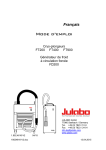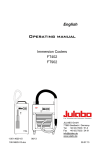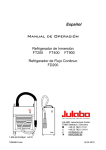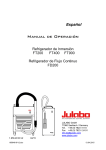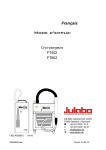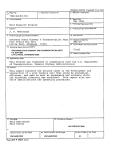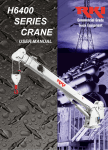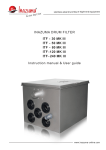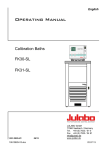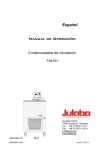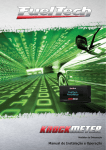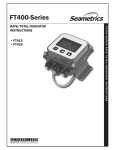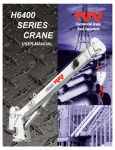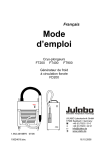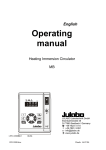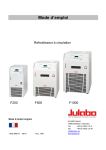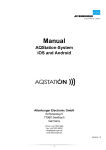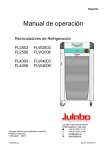Download Operating manual
Transcript
English Operating manual Immersion Coolers FT200 FT400 FT900 Flow-Through Cooler FD200 FT900 FT 400 1.951.4616-V2 19514616-V2.doc JULABO GmbH 77960 Seelbach / Germany Tel. +49 (0) 7823 / 51-0 Fax +49 (0) 7823 / 24 91 [email protected] www.julabo.de 06/13 26.07.2013 Congratulations! You have made an excellent choice. JULABO thanks you for the trust you have placed in us. This operating manual has been designed to help you gain an understanding of the operation and possible applications of our immersion coolers. For optimal utilization of all functions, we recommend that you thoroughly study this manual prior to beginning operation. The JULABO Quality Management System Temperature control devices for research and industry are developed, produced, and distributed according to the requirements of ISO 9001 and ISO 14001. Certificate Registration No. 01 100044846 Unpacking and inspecting Unpack the immersion cooler and accessories and inspect them for possible transport damage. Damage should be reported to the responsible carrier, railway, or postal authority, and a damage report should be requested. These instructions must be followed fully for us to guarantee our full support of your claim for protecting against loss from concealed damage. The form required for filing such a claim will be provided by the carrier. Printed in Germany Changes without prior notification reserved Important: keep operating manual for future use 2 TABLE OF CONTENTS OPERATING MANUAL............................................................................................... 4 1. INTENDED USE ......................................................................................... 4 1.1. Description ................................................................................................ 4 2. OPERATOR RESPONSIBILITY – SAFETY INSTRUCTIONS ................... 4 2.1. Disposal .................................................................................................... 6 2.2. EC Conformity........................................................................................... 7 2.3. Warranty conditions .................................................................................. 7 2.4. Technical specifications ............................................................................ 8 OPERATING INSTRUCTIONS ................................................................................. 10 3. OPERATING CONTROLS AND FUNCTIONAL ELEMENTS ................... 10 4. SAFETY NOTES FOR THE USER ........................................................... 12 4.1. Explanation of safety notes ..................................................................... 12 4.2. Explanation of other notes ...................................................................... 12 4.3. Safety instructions................................................................................... 13 5. PREPARATIONS...................................................................................... 14 5.1. Installation ............................................................................................... 14 5.2. Immersion Probe..................................................................................... 14 5.3. Tube connection FD200 .......................................................................... 15 6. OPERATING PROCEDURES .................................................................. 15 6.1. Power connection ................................................................................... 15 6.2. Switching On ........................................................................................... 16 7. TROUBLESHOOTING.............................................................................. 17 8. CLEANING / REPAIRING THE UNIT ....................................................... 17 3 Operating manual Operating manual 1. Intended use JULABO immersion coolers have been designed for temperature application to specific fluids in a bath tank. For example: Dewar vessels, beakers, or other containers in conjunction with heating circulators for continuous countercooling or for dry-ice substitution. JULABO immersion coolers are not suitable for direct temperature control of foods, semi-luxury foods and tobacco, or pharmaceutical and medical products. Direct temperature control means unprotected contact of the object with the bath medium (bath fluid). 1.1. Description The JULABO immersion coolers FT200, FT 400 and FT900 are employed to cool liquids for working temperatures ranging from +50 °C to -90 °C, such as in: Dewar vessels, beakers, or other containers in conjunction with heating circulators for continuous countercooling or for dry-ice substitution. The JULABO FD200 Flow-Through Cooler is employed to cool liquids in closed circuits. This unit is generally installed at the intake of a heating circulator to draw heat away from the circulating bath liquid. Models FD200, FT200 and FT400 are provided with a handle for portable use. Model FT900 is equipped with four castors. Two of the castors include locking levers that should be pressed down after setting up the unit to prevent it from moving. The immersion probe is connected to the instrument with a flexible, specially insulated tube. On model FT900 the immersion probe is also flexible and may be adjusted precisely to different positions within the vessel. 2. Operator responsibility – Safety instructions The products of JULABO ensure safe operation when installed, operated, and maintained according to common safety regulations. This section explains the potential dangers that may arise when operating the circulator and also specifies the most important safety precautions to preclude these dangers as far as possible. The operator is responsible for the qualification of the personnel operating the units. The personnel operating the units should be regularly instructed about the dangers involved with their job activities as well as measures to avert these dangers. Make sure all persons tasked with operating, installing, and maintaining the unit have read and understand the safety information and operating instructions. When using hazardous materials or materials that could become hazardous, the circulator may be operated only by persons who are absolutely familiar with these materials and the circulator. These persons must be fully aware of possible risks. 4 If you have any questions concerning the operation of your unit or the information in this manual, please contact us! Contact JULABO GmbH Eisenbahnstraße 45 77960 Seelbach / Germany Tel. +49 (0) 7823 / 51-0 Fax +49 (0) 7823 / 24 91 [email protected] www.julabo.de Safety instructions for the operator: Avoid strikes to the housing, vibrations, damage to the operating-element panel (keypad, display), and contamination. Make sure the product is checked for proper condition regularly (depending on the conditions of use). Regularly check (at least every 2 years) the proper condition of the mandatory, warning, prohibition and safety labels. Make sure that the mains power supply has low impedance to avoid any negative effects on the instruments being operated on the same mains. This unit is designed for operation in a controlled electromagnetic environment. This means that transmitting devices (e.g., cellular phones) should not be used in the immediate vicinity. Magnetic radiation may affect other devices with components sensitive to magnetic fields (e.g., monitors). We recommend maintaining a minimum distance of 1 m. Permissible ambient temperature: max. 40 °C, min. 5 °C. Permissible relative humidity: 50% (40 °C). Do not store the unit in an aggressive atmosphere. Protect the unit from contamination. Do not expose the unit to sunlight. Appropriate operation Only qualified personnel is authorized to configure, install, maintain, or repair the circulator. Persons who operate the circulator must be trained in the particular tasks by qualified personnel. The summarized user guidance (short manual) and the specification table with information on individual parameters are sufficient for this. Use The bath can be filled with flammable materials. Fire hazard! There might be chemical dangers depending on the bath medium used. Observe all warnings for the used materials (bath fluids) and the respective instructions (safety data sheets). Insufficient ventilation may result in the formation of explosive mixtures. Only use the unit in well ventilated areas. Only use recommended materials (bath fluids). Only use non-acid and non corroding materials. 5 Operator responsibility – Safety instructions When using hazardous materials or materials that could become hazardous, the operator must affix the enclosed safety labels (1 + 2) to the front of the unit so they are highly visible: 1 Warning label W00: Colors: yellow, black Danger area. Attention! Observe instructions. (operating manual, safety data sheet) 2 Mandatory label M018: Colors: blue, white Carefully read the user information prior to beginning operation. Scope: EU or Semi S1-0701 Table A1-2 #9 Carefully read the user information prior to beginning operation. Scope: USA, NAFTA 2 Particular care and attention is necessary because of the wide operating range. There are thermal dangers: Touchable parts of the probe can be very cold. The user must attach the enclosed safety labels to the unit so they are well visible. Safety label including warning label W017: Colors: yellow, black Attention: Do not touch cold probe. -40 °C / -90 °C 2.1. Disposal The product may be used with oil as bath fluid. These oils fully or partially consist of mineral oil or synthetic oil. For disposal, follow the instructions in the material safety data sheets. This unit contains the refrigerants R134a R404A, and R-23, which at this time are not considered harmful to the ozone layer. However, over the long operating period of the unit, disposal rules may change. Therefore, only qualified personnel should handle the disposal. Valid in EU countries See the current official journal of the European Union – WEEE directive. Directive of the European Parliament and of the Council on waste electrical and electronic equipment (WEEE). This directive requires electrical and electronic equipment marked with a crossed-out trash can to be disposed of separately in an environmentally friendly manner. Contact an authorized waste management company in your country. Disposal with household waste (unsorted waste) or similar collections of municipal waste is not permitted! 6 2.2. EC Conformity The products described in the operating instructions conform to the requirements of the following European guidelines: Directive of the European Parliament and of the Council on the approximation of the laws of the Member States relating to machinery. Low voltage regulations with respect to legal harmonization of the member countries concerning electric devices for use within certain voltage limits. EMC guideline with respect to legal harmonization of the member countries concerning electromagnetic compatibility. JULABO GmbH Eisenbahnstr. 45 77960 Seelbach / Germany 2.3. Warranty conditions JULABO GmbH warrants its products against defects in material or in workmanship, when used under appropriate conditions and in accordance with appropriate operating instructions for a period of ONE YEAR. Extension of the warranty period – free of charge With the ‘1PLUS warranty’ the user receives a free of charge extension to the warranty of up to 24 months, limited to a maximum of 10 000 working hours. To apply for this extended warranty the user must register the unit on the JULABO web site www.julabo.de, indicating the serial no. The extended warranty will apply from the date of JULABO GmbH’s original invoice. JULABO GmbH reserves the right to decide the validity of any warranty claim. In case of faults arising either due to faulty materials or workmanship, parts will be repaired or replaced free of charge, or a new replacement unit will be supplied. Any other compensation claims are excluded from this guarantee. 7 Operator responsibility – Safety instructions 2.4. Technical specifications Temperature range Cooling capacity (medium ethanol) Refrigerant Recommanded flow rate Freezing protection Immerson probe (Lxdia.) Connection tubing (L) Dimensions (WxLxH) Weight Ambient temperature °C °C kW l/min °C cm cm cm kg °C FT200 -20 … +30 +20 0 -30 0.25 0.15 0.04 R134a --------9x4 120 18x27x39 18 5 ... 35 Mains power connection Current draw (at 230 V) Mains power connection Current draw (at 115 V) V/Hz A V/Hz A 190-253 /50 1.5 103-127 / 60 3.0 230/50 1.5 115 / 60 3.0 FT400 -40 ... +30 FT900 -90 ... +30 +20 +10 -20 -40 0.45 0.36 0.14 0.03 +20 +10 -40 -80 0.3 0.27 0.2 0.7 2- stage R404A/R23 65x1.5 (flexible) 160 38x55x60 50 5 ... 35 190-253 / 50-60 5.5 103-127 / 60 7.0 Temperature range Cooling capacity (medium ethanol) Cooling compressor Refrigerant Immerson probe (Lxdia.) Connection tubing (L) Dimensions (WxLxH) Weight Ambient temperature °C °C kW cm cm cm kg °C 1-stage R404A 12x5 120 20x30x43 24 5 ... 35 Mains power connection Current draw (at 230 V) Mains power connection Current draw (at 115 V) V/Hz A V/Hz A 190-253 /50 4 103-127 / 60 3.5 Note: All measurements have been carried out at: rated voltage and frequency; ambient temperature 20 °C; 8 FD200 10 … +30 +20 +10 0.22 0.18 R134a 2-3 10 --------18x27x39 16 5 ... 35 Environmental conditions according to IEC 61 010-1: Use indoors only. Altitude up to 2000 m - normal zero. Ambient temperature: see Technical specifications Humidity: Max. relative humidity 80% for temperatures up to +31 °C, linear decrease down to 50% relative humidity at a temperature of +40 °C Max. mains voltage fluctuations of ±10% are permissible. Protection class according to IEC 60 529 The unit corresponds to Class I Overvoltage category Pollution degree IP21 II 2 Caution: The unit is not for use in explosive environment. EMC requirements according to EN 61326-1 9 Operating instructions Operating instructions 3. OPERATING CONTROLS AND FUNCTIONAL ELEMENTS FT400 FT200 Rear view 2 2 1 1 12 3 FT 400 3 10 A M P 10 A M P 11 FT 400 FD200 1 Mains switch, illuminated 2 Cooling control light 3 Clamp for immersion probe 7 Removable ventilation grid 8 Castor with locking lever 9 Tube connection - discharge 10 Tube connection - intake 11 12 Mains power cable with plug Safety cutouts: Mains fuses 10 A 1 9 10 10 FD 200 FT900 Rear view 2 1 FT900 3 11 7 8 11 Safety notes for the user 4. 4.1. Safety notes for the user Explanation of safety notes In addition to the safety warnings listed above, warnings are posted throughout the manual. These warnings are designated by an exclamation mark inside an equilateral triangle. “Warning of a dangerous situation (Attention! Please follow the documentation).” The danger is classified using a signal word. Read and follow these important instructions. Warning: Describes a possibly highly dangerous situation. If these instructions are not followed, serious injury and danger to life could result. Caution: Describes a possibly dangerous situation. If this is not avoided, slight or minor injuries could result. A warning of possible property damage may also be contained in the text. Notice: Describes a possibly harmful situation. If this is not avoided, the product or anything in its surroundings can be damaged. 4.2. Explanation of other notes Note! Draws attention to something special. Important! Indicates usage tips and other useful information. 12 4.3. Safety instructions Follow the safety instructions to avoid personal injury and property damage. Also, the valid safety instructions for workplaces must be followed. Only connect the unit to a power socket with an earthing contact (PE – protective earth)! The power supply plug serves as a safe disconnecting device from the line and must always be easily accessible. Place the unit on an even surface on a base made of nonflammable material. Do not stay in the area below the unit. Make sure you read and understand all instructions and safety precautions listed in this manual before installing or operating your unit. Do not touch the immersion probe if it is frosted. Do not bend the tube connection of the immersion probe Keep the air intake and exhaust grids free of obstructions. (Maintain a sufficient distance from all surrounding surfaces!) Do not move the unit from the position where it was set up during operation. Always turn off the unit and disconnect the mains cable from the power source before performing any service or maintenance procedures, or before moving the unit. Always turn off the unit and disconnect the mains cable from the power source before cleaning the unit. Transport the unit with care. Sudden jolts or drops may cause damage in the interior of the unit. Observe all warning labels. Never remove warning labels. Never operate units with damaged mains power cables. Repairs are to be carried out only by qualified service personnel. There are thermal dangers: Touchable parts of the probe can be very cold. Therefore, exercise particular caution when touching these parts. Use gloves. 13 Preparations 5. 5.1. Preparations Installation 5.2. Place the unit on an even surface on a pad made of non-flammable material. Press down the castor levers on model FT900. The instrument should be set up at a frost-proof and dry location. The place of installation should be large enough and provide sufficient air ventilation to ensure the room does not warm up excessively because of the heat the instrument rejects to the environment. (Max. permissible ambient temperature: 35 °C). For a fault (leakage) in the refrigeration system, the standard EN 378 prescribes a certain room space to be available for each kg of refrigerant. > For 0.25 kg of refrigerant R134a, 1 m3 of space is required. > For 0.52 kg of refrigerant R404A, 1 m3 of space is required. > For 0.68 kg of refrigerant R23, 1 m3 of space is required. The ambient temperature must not exceed 35 °C. Keep at least 20 cm of open space on the front and rear venting grids. Do not set up the unit in the immediate vicinity of heat sources and do not expose to sun light. Before operating the unit after transport, wait about one hour after setting it up. This will allow any oil that has accumulated laterally during transport to flow back down thus ensuring maximum cooling performance of the compressor. Immersion Probe Avoid touching the immersion probe if it is frosted. DANGER OF INJURY. Use gloves. Switch the unit on only if the probe is immersed into the bath fluid. To prevent the immersion probe (A) from icing, it should be completely immersed into the bath liquid (B). FT900 FT200 FT400 A A B B 120 mm (minimum) 14 Accessory: Clamp for cooler probe FT200/400 - order no. 8 970 400 5.3. Tube connection FD200 Connect the tubes and secure with tube clamps. discharge (9) intake (10) Recommended flow rate: 6. 6.1. 2 to 3 l/min OPERATING PROCEDURES Power connection Caution: Only connect the unit to a power socket with earthing contact (PE – protective earth)! The power supply plug serves as safe disconnecting device from the line and must be always easily accessible. Never operate equipment with damaged mains power cables. Regularly check the mains power cables for material defects (e.g. for cracks). We disclaim all liability for damage caused by incorrect line voltages! Make sure that the line voltage and frequency match the supply voltage specified on the type plate. Deviations of ±10 % are permissible. 15 6.2. Switching On The immersion cooler is turned on and off with the mains switch. (1). The control light in the switch will illuminate. The immersion probe – as part of the cooling circuit – should not be exposed to bath temperatures above the working temperature of the immersion cooler. This would cause damage to the compressor. Do not immerse a frosted immersion probe into hot bath oil. DANGER OF INJURY! 19514616-V2.doc 26.07.2013 7. 8. TROUBLESHOOTING Malfunction of compressor: The cooling compressor is equipped with an overload protection device that will be triggered by overheating or excessive current consumption. Possible causes include insufficient ventilation or contamination of the condenser. After a cool-down phase, the motor is automatically switched on again. Interruption of the cooling loop (FD200) by a bended tube. Cleaning / repairing the unit Caution: Before cleaning the unit, disconnect the power plug from the mains socket! Always turn off the unit and disconnect the mains cable from the power source before performing any service or maintenance procedures. Service and repair work may be performed only by authorized electricians. Prevent humidity from entering into the immersion cooler. JULABO coolers are designed for continuous operation under normal conditions. Periodic maintenance is not required. Regularly check the condensor for dirt contamination. Clean the ribbed condensor, because dust and dirt will reduce cooling performance of the unit. Cleaning the Cooling Compressor: FT 400 Switch off the unit, disconnect mains power cable. Remove the hood (FD200, FT200, FT400). 17 Cleaning / repairing the unit FT900 The ventilation grid (7) is detached by unscrewing the four mouting screws (FT900). Clean the ribbed condensor with a vacuum cleaner. Replace the hood or the ventilation grid. Switch on the unit. Clean the outside of the unit using a wet cloth and low surface tension water. Repairs Before asking for a service technician or returning a JULABO instrument for repair, please contact an authorized JULABO service station. When returning the unit: Clean the unit in order to avoid any harm to the service personnel. Attach a short fault description. During transport the unit has to stand upright. Mark the packing correspondingly. When returning a unit, take care of careful and adequate packing. JULABO is not responsible for damages that might occur from insufficient packing. 18 19 Cleaning / repairing the unit 20




















